Salient Features of the Constitution of India Chapter Notes | Legal Studies for Class 11 - Humanities/Arts PDF Download
Meaning of the term Constitution
The term Constitution comes from the Latin word “constitutio,” which means 'to establish'. According to the Oxford Latin Mini Dictionary, a Constitution is a ‘body of fundamental principles or established precedents under which a State or other organisation is governed’. Wade & Phillips in their book 'Constitution and Administrative Law' explain that a country's Constitution aims to set up its fundamental governing bodies, detailing their structure, composition, powers, and main functions. It outlines how these bodies interact with each other and their relationship with the people, especially politically.
The Constitution defines the duties, powers, and roles of different government bodies. It clarifies the relationships among these bodies, the State, and its citizens. Therefore, a Constitution is a mutually accepted document that ‘establishes' how people agree to govern themselves.
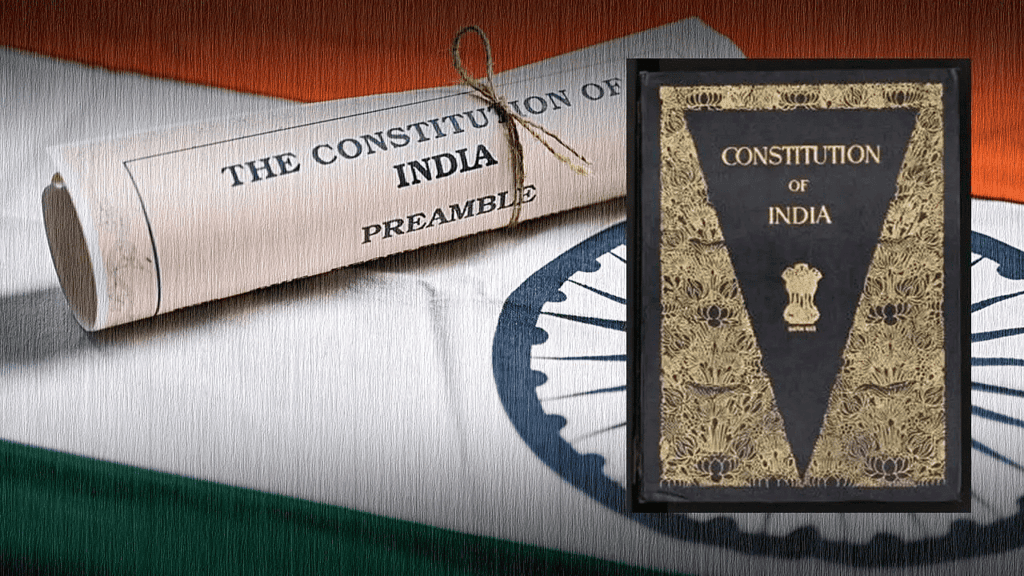
Definition of the term Constitution
In its modern context, a State's Constitution may have the following distinctive features:
- It is a body of rules.
- It can be in written or unwritten form.
- It defines the powers and responsibilities of the State and its government bodies.
- It can be contained in a single document or multiple documents.
- It outlines the rights and duties of citizens.
- It serves as the fundamental law of a State.
The features of a Constitution can differ from one state to another. A state's government operates based on the principles established in its Constitution, which helps maintain order and law. Georg Jellinek (1851-1911) argued that without a Constitution, individuals, institutions, and even the government may disregard the law, leading to a ‘reign of anarchy’.
The Constitution of India, effective from 26 January 1950, is the longest written Constitution globally. Durga Das Basu in 'Introduction to the Constitution of India' notes that "the Constitution of India is the longest, most detailed, and elaborate constitutional document ever created." It contains 395 Articles (with many added and some repealed through amendments). Originally, it had 8 schedules; now, it has 12.
Constituent Assembly
- Formation of the Congress Party: In 1885, Allan Octavian Hume, an Englishman, established the Congress Party to allow Indians to engage with the British Government.
- Leadership Transition: In 1921, after World War I, Mahatma Gandhi took over the Congress Party and led the movement for India's independence.
- Constituent Assembly Composition: The members of the Constituent Assembly were mainly from the Congress Party, with a few Communists and Independents included.
- Role of the Congress Party: The Constituent Assembly was largely connected to the Congress Party, but it also included individuals with legal and public affairs expertise to aid in drafting the constitution.
- Leadership in Constitution Drafting: Bhimrao Ramji Ambedkar, the first law minister of India, chaired the Constitution Drafting Committee and is acknowledged as the main architect of the Indian Constitution.
- Dual Responsibilities: The Constituent Assembly had two main roles: handling governance matters in the mornings and working on the Constitution in the afternoons.
- First Meeting: The first meeting of the Constituent Assembly took place on December 9, 1946, marking the official start of the constitution-making process.
- Establishment of Dominions: The Indian Independence Act of 1947 stated that from August 15, 1947, two independent Dominions, named India and Pakistan, would be created
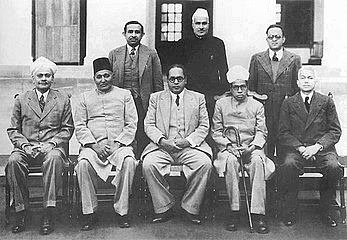
Sources of the Constitution of India
- The Constitution of India was created by the Constituent Assembly, drawing from three main sources: the Government of India Act of 1935, constitutions from other countries, and the Objectives Resolution of December 1946.
- The first source was the Government of India Act of 1935, which was the foundational document until 1950. Key features of the 1935 Act included a parliamentary system (with ultimate power retained by the British), a centralised federal system, and provisions for elections to provincial legislatures.
- The second source came from the constitutions of other nations. These were mainly referenced in the chapters on Fundamental Rights and Directive Principles of State Policy. Fundamental Rights focus on civil and political rights, such as the right to life and freedom of speech, while Directive Principles emphasise economic, social, and cultural rights.
- The third source was the Objectives Resolution adopted in December 1946. The spirit of the Constitution was derived from this resolution. It outlined the philosophy that the Constitution later expressed through its detailed provisions. Jawaharlal Nehru drafted the Objectives Resolution, highlighting justice, equality, freedom, and protections for minorities and disadvantaged groups.
- The Objectives Resolution advocated for the integrity of the Indian Union, stating that its power comes from the Indian people. It aimed for national unity, democracy, and social progress for the welfare of citizens.
Historical Perspective of Constitution of India
The Indian Constitution has evolved through various phases, influenced by colonial rule, freedom struggles, and legislative developments. Before Independence, India's constitutional framework was shaped by several British-enacted laws, laying the foundation for governance and administration.
Before Independence
- British Colonial Rule: India was under British rule.
- Sovereignty: The British Crown had sovereignty over India.
- Significant Legislations:
- Government of India Act, 1858
- Indian Councils Act, 1861
- Indian Councils Act, 1892
- Indian Councils Act, 1909
- Government of India Act, 1919
- Government of India Act, 1935
- Role of Government of India Act, 1935: This Act outlined the administrative framework and language for the Constitution.
- Autonomy to Provinces: Provinces received autonomy through the division of legislative and executive powers.
- Central Government: The Central legislature had two houses: the Federal Assembly and the Council of States.
- Legislative Powers: Powers were divided into the Federal List, Provincial List, and Concurrent List.
- Limited Self-Governance: Indians were granted very limited self-governance, causing widespread protests due to dissatisfaction.
- Constituent Assembly: It was agreed to form an independent Constituent Assembly to draft the Constitution without outside interference.
- Salient Features of the 1935 Act:
- Provided a parliamentary system, but ultimate power remained with the British;
- Included a comprehensive administrative structure;
- Established a centralised federal system;
- Allowed for elections to provincial legislatures or assemblies.
The Indian Independence Act, 1947
- The Indian Independence Act of 1947 was passed by the British Parliament, received Royal Assent, and started on July 18, 1947, marking a crucial change in India's history.
- From August 15, 1947, known as the 'appointment date' in the Government of India Act, 1935, two independent Dominions, named India and Pakistan, were to be formed.
- Each Dominion's Constituent Assembly had full authority to create and adopt any Constitution, including the power to cancel any British Parliament Act, even the Indian Independence Act.
- The Constituent Assembly was made up of members elected from provincial and state legislatures, which is key to its legitimacy and structure.
- Dr. Bhim Rao Ambedkar, the Law Minister, led the Drafting Committee from August 15, 1947, to January 26, 1950, guiding the development of the Constitution of India.
- After thorough discussions considering administrative issues, geographical factors, social and cultural differences, and historical contexts, a proposal for the Draft Constitution of India was created.
- The draft was approved by the Assembly President, Dr. Rajendra Prasad, and was officially passed on November 26, 1949. The Constituent Assembly met 11 times and took 2 years, 11 months, and 18 days to finalise two copies of the document.
- The original Constitution of India, beautifully handwritten by Prem Behari Narain Raizada, was signed in two versions - 'Bhartiya Sanvidhan' in Hindi and 'The Constitution of India' in English, with each page artistically decorated by Shantiniketan artists like Beohar Rammanohar Sinha and Nandalal Bose.
- The Constitution of India took effect on January 26, 1950, marking an important milestone following the Independence Act.
Salient Features of The Constitution Of India
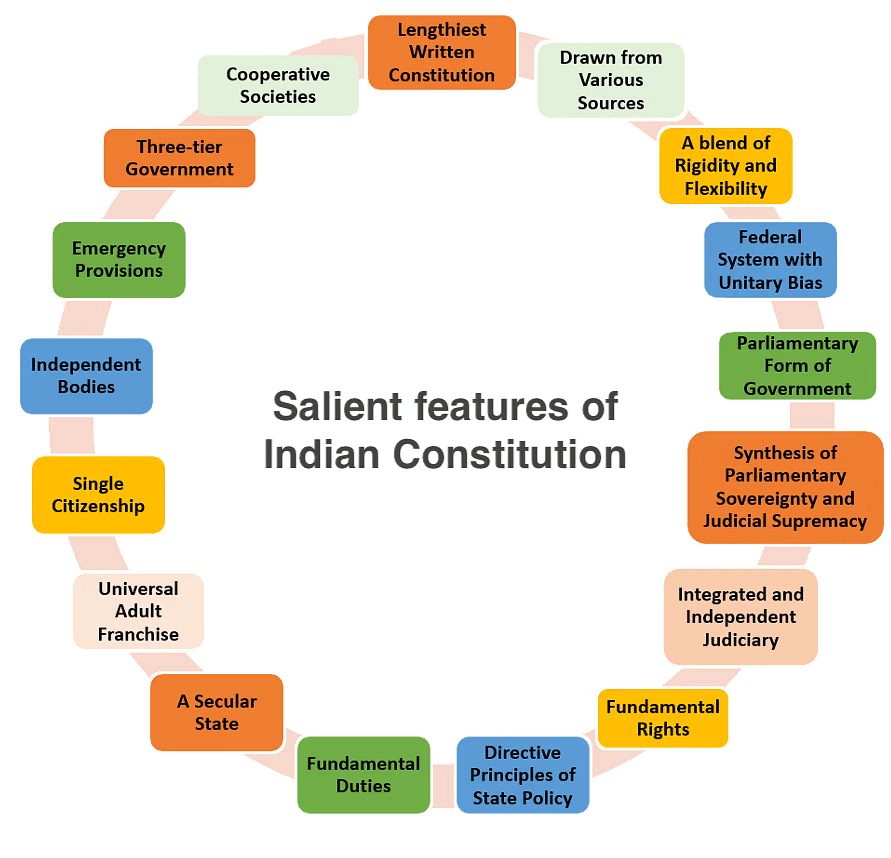
1. A Modern Constitution
- Background: The Constitution of India was created in the mid-20th century, combining important elements from various constitutions to fit India's needs.
- Union of States: Article 1(1) states that India, also known as Bharat, is a Union of States, bringing together all 552 Indian States within the geographical boundaries established on 15 August 1947.
- Unity Emphasis: Dr. B.R. Ambedkar stressed the use of the term 'Union' instead of 'Federation' during the Constituent Assembly Debates, highlighting India's symbolic unity, where states cannot leave the Union without consent.
- Federal Features: Although India functions as a federal state, the Constitution permits a shift to a unitary system during emergencies, as outlined in Part XVIII, which is a unique feature of Indian governance.
- Unique Elements: India was established as a 'Union of States' with a highly centralised federal structure, placing a strong emphasis on the central government in relation to the states.
- Legal Influences: Many sections of the Constitution are inspired by various legal systems, such as the Fundamental Rights echoing the American Bill of Rights and Directive Principles influenced by the Irish Constitution.
- Government Structure: India chose a Parliamentary system similar to the British model, opting against a Presidential system to prevent potential conflicts between government branches.
- Amendments and Additions: The 73rd and 74th Constitution Amendment Act of 1993 introduced Part IX and Schedules XI & XII to the Constitution, expanding provisions for Panchayats, Municipalities, and other governance frameworks.
The Directive Principles of State Policy in Part IV of the Constitution are not enforceable in courts, but they are essential for governance, and it is the state's responsibility to implement these principles when making laws.
2. Lengthiest Written Constitution
- Durga Das Basu mentions in his book 'Introduction to the Constitution of India' that "the Constitution of India is the longest and most detailed constitutional document in the world."
- It has 395 Articles, with some added and others removed through amendments.
- The Constitution originally had 8 schedules, but now it includes 12 Schedules.
- Drafting the Constitution took almost three years (specifically, two years, eleven months, and seventeen days). The Constituent Assembly met for eleven sessions over 165 days, with 114 days dedicated to reviewing the Draft Constitution.
- The original Constitution is beautifully hand-written by Prem Behari Narain Raizada.
- Artists from Shantiniketan, such as Beohar Rammanohar Sinha and Nandalal Bose, decorated each page
3. Preamble to the Constitution
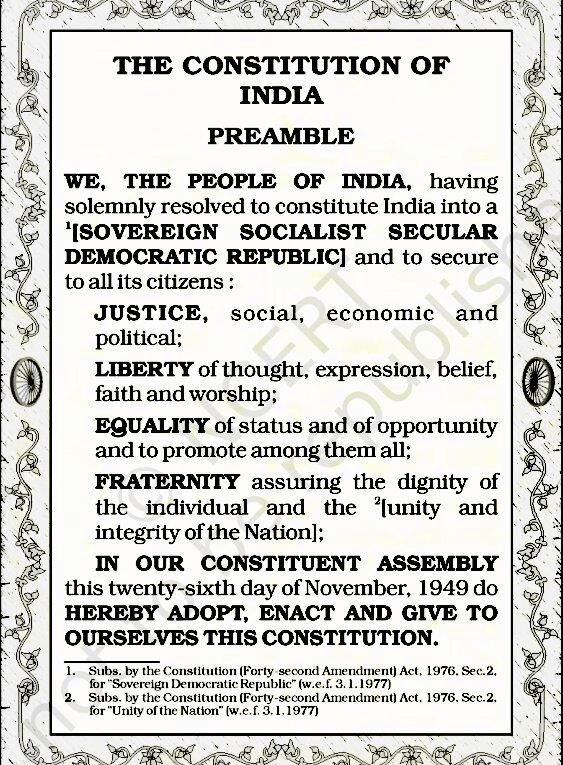
- Introduction: The Constitution commences with an initial statement known as the preamble.
- Guiding Principles: As per the Objectives Resolution, it establishes the fundamental principles and ideology of the Constitution, emphasizing unity and integrity.
- Significance: The Preamble is deemed an integral part of the Constitution, embodying the basic framework of the document.
- Interpretation: It functions as a guiding tool for understanding and interpreting the Constitution's provisions.
- Key Features: The Preamble asserts that the Indian populace has adopted and granted themselves the Constitution.
- Legal Interpretation: Court cases like Keshavananda Bharati v. Union of India and Charan Lal Sahu v. Union Of India have elucidated the constitutional implications of terms like "sovereign," "democratic," and "republic."
- Core Objectives: The Preamble aims to secure justice, liberty, equality, fraternity, unity, and integrity for all citizens.
4. Fundamental Rights; Directive Principles of State Policy; Fundamental Duties
Fundamental Rights:
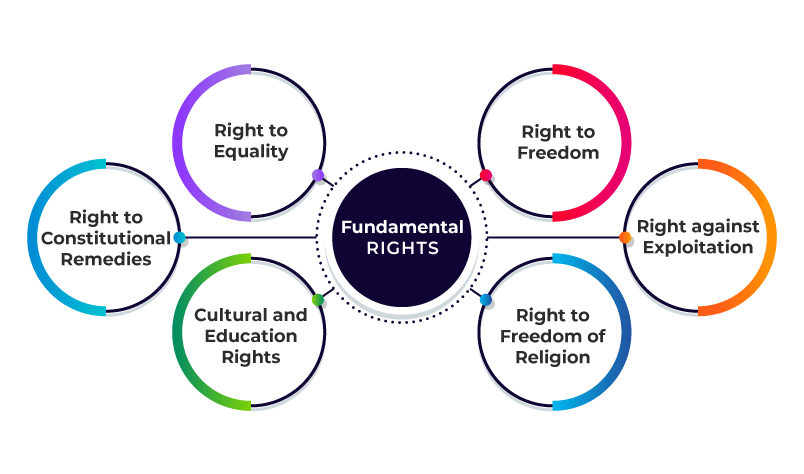
- Constitutional Framework: Fundamental Rights in India are enshrined in Part III of the Constitution.
- Rights Included: These rights cover aspects like equality, freedom, protection, and remedies.
- Enforceability: Fundamental Rights are justiciable, meaning they can be enforced through the courts.
- Scope of Rights: They ensure equality before the law, freedom of speech, protection of life and liberty, and more.
- Guarantee and Enforcement: Violations of these rights render legislative and executive actions unconstitutional.
- Judicial Authority: The Supreme Court and High Courts hold powers to issue orders for the enforcement of these rights.
- Meaning of Writs: A "writ" refers to a formal written order issued by a court or judicial authority. Writs are typically issued to direct someone to do something specific, refrain from doing something, or to enforce a legal right. They are fundamental tools used in the administration of justice to ensure that individuals' rights are protected and upheld. Writs like habeas corpus, mandamus, prohibition, quo warranto, and certiorari ensure the protection of Fundamental Rights.
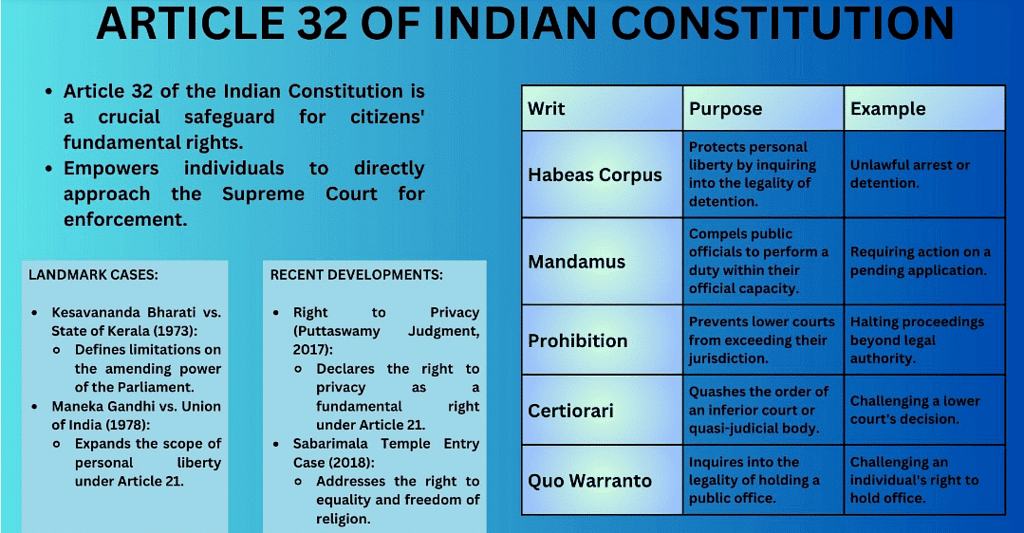
Directive Principles
- Definition: The Directive Principles of State Policy are principles outlined in Part IV of the Constitution, guiding state policies in the social sector.
- Nature: They focus on economic and social rights, embodying socialist ideals to fulfill the social revolution agenda of the preamble.
- Enforceability: While not enforceable by courts, they offer guidance for drafting laws concerning human and social development.
- State's Duty: It is the State's duty to apply these principles in lawmaking to promote the welfare of the people.
- Key Provisions: Include rights such as adequate livelihood, equal pay for equal work, village Panchayats, and promotion of educational and economic interests of marginalized sections.
- Legislation: Various laws have been enacted to implement these principles, such as the Legal Services Authority Act and the Right to Education Act.
- Judicial Interpretation: Some Directive Principles have been elevated to the status of Fundamental Rights by the Supreme Court, emphasizing their importance in governance.
Fundamental duties
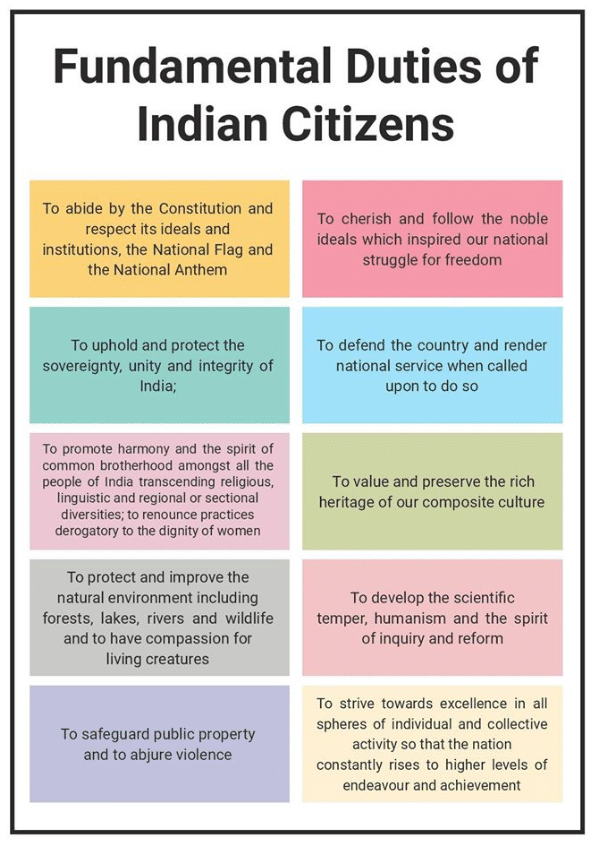
- The Constitution (42nd Amendment) Act, 1976 introduced Part IV-A, Article 51-A on Fundamental Duties of citizens.
- There are eleven Fundamental Duties outlined in the Constitution.
- The Constitution does not have a provision for the enforcement of Fundamental Duties.
- In the case of Bijoe Emmanuel v. State of Kerala (AIR 1987 SC 478), the Supreme Court ruled that duties can potentially be enforced through the enactment of legislation.
- For instance, the Prevention of Insult to National Honours Act, 1971 penalizes individuals who insult national honours.
- Fundamental Duties are to be considered in conjunction with Fundamental Rights.
- The judiciary, as emphasized in the case of Mohan Kumar v. Union of India (AIR 1992 SC 1), has the authority to enforce these duties while preserving a balance with Fundamental Rights.
5. Constitutional Provision for Amendment of the Constitution of India
- Part XX of the Constitution of India explains the process for amending the Constitution.
- Article 368 outlines Parliament's authority to amend the Constitution and the procedure to be followed.
- No restrictions exist on Parliament's power to amend by adding, removing, or enhancing provisions.
- The first step involves introducing a Bill in either House of Parliament, requiring a specific majority for passage.
- Some amendments mandate ratification by at least half of the State Legislatures before the President's assent.
- In the Kesavananda Bharti v. State of Kerala case, the Supreme Court limited Parliament's authority to amend the Constitution's Basic Structure.
6. Adult Suffrage

- Article 326: Grants Indian citizens the right to vote in general elections to the House of People and State Legislative Assemblies.
- Eligibility: Every citizen above 18 years of age (reduced from 21 years by the Constitution) can vote unless disqualified for reasons like unsoundness of mind, non-residence, crime, or corrupt practices.
- Electoral Roll: One general electoral roll for each territorial constituency as per Article 325, covering elections for Parliament or State Legislature.
- Inclusion Criteria: No one can be excluded from the electoral roll based solely on religion, race, caste, or sex.
- Reserved Seats: Articles 330 and 332 reserve seats for Scheduled Castes and Scheduled Tribes in the House of People and Legislative Assemblies respectively.
- Anglo-Indian Representation: Article 331 provides representation for the Anglo-Indian community in the House of People.
- Basic Structure: In the case of Indira Nehru Gandhi v. Raj Narain (popularly known as the Election case), the right to free and fair elections is declared as part of the Basic Structure of the Constitution.
 |
Download the notes
Chapter Notes: Salient Features of the Constitution of India
|
Download as PDF |
7. Single Citizenship in India
- Citizenship Provision: The Constitution of India offers single citizenship.
- Acquisition Methods: Citizenship in India can be acquired through birth, descent, registration, and naturalization.
- By Birth: Every individual born in India to non-illegal migrant parents is granted citizenship.
- By Registration: Citizenship can be obtained through registration, typically requiring at least 7 years of residency.
- By Descent: Citizenship is conferred if at least one parent is an Indian citizen.
- By Naturalization: Citizenship through naturalization is possible after being a resident of India for 12 years.
- Political and Civil Rights: Indian citizens enjoy various rights such as voting, contesting elections, and holding high offices like President, Vice President, Governor, and Judges, subject to specific criteria.
8. Independent Judiciary in the Constitution of India
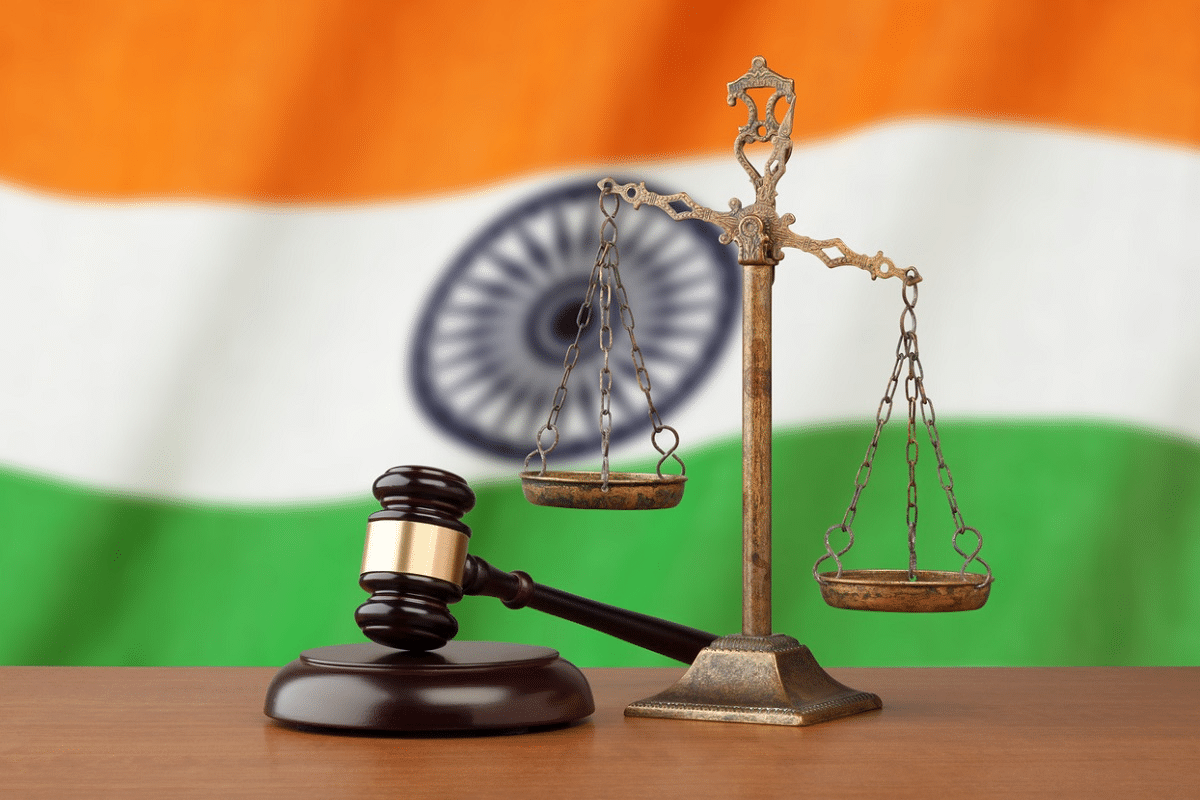
- Independence of Judiciary: The Constitution of India ensures that the judiciary operates independently, free from the influence of other branches of the government.
- Judiciary Principles: The judiciary in India functions based on the established principles outlined in the Constitution.
- Constitutional Provisions: The provisions within the Indian Constitution safeguard the autonomy and integrity of the judiciary.
- Separation of Powers: The judiciary's independence signifies the separation of powers between the three branches of government.
- Role of the Judiciary: The judiciary plays a crucial role in upholding justice and interpreting laws impartially.
- Case Law: Landmark cases have contributed to the evolution of judicial independence in India, such as Kesavananda Bharati v. State of Kerala.
- Significance: An independent judiciary ensures fairness, transparency, and accountability in the legal system of India.
9. Emergency Provisions
- Constitutional Provisions for Emergencies:
- The Constitution makers foresaw situations when normal governance might not be feasible.
- The Constitution's Part XVIII details emergency provisions.
- Types of Emergencies:
- War, Aggression, and Rebellion: Emergency due to war, external aggression, or armed rebellion is declared under Article 352.
- Failure of Constitutional Machinery: Emergency due to the breakdown of constitutional mechanisms in states as per Articles 356 & 365.
- Financial Emergency: Declared under Article 360.
- Purpose of Emergency Provisions:
- The provisions safeguard the nation's sovereignty, unity, integrity, and security, along with the democratic system and the Constitution.
- Centralization of Power:
- During an emergency, the central government gains extensive authority, and states come under central control.
- Political System Transformation:
- The political system shifts from federal (normal times) to unitary (during emergencies), a distinctive aspect of the Indian Constitution.
10. Federal in Form, Unitary in Character
- The Constitution of India establishes a federal system of government.
- It contains features of a federation, such as two governments, division of powers, written constitution, the supremacy of the constitution, independent judiciary, and bicameralism.
- Additionally, it includes unitary or non-federal features like a strong Centre, single Constitution, appointment of state governor by the Centre, all-India services, integrated judiciary, etc.
- The term 'Federation' is not explicitly used in the Constitution.
- India is described as a 'Union of States' in Article 1, implying that Indian Federation is not a result of a state agreement and no state has the right to secede.
- Dr. B.R. Ambedkar noted that the word 'Union' reflects the Assembly's commitment to keep the nation united.
11. Division of Power - Centre-State Relations
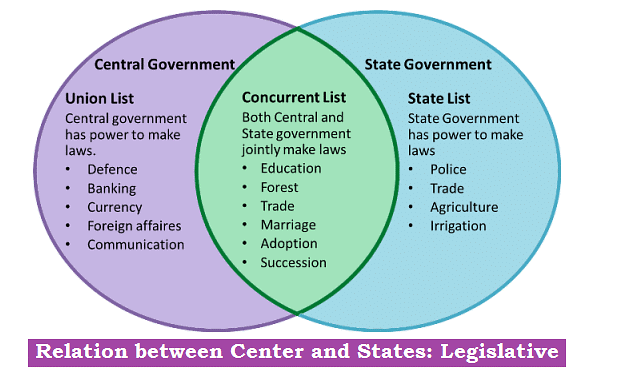
- Various articles and schedules of the Constitution define the powers of the central and state governments and their relations.
- The Seventh Schedule contains three legislative lists: Union list, State list, and Concurrent list, which outline legislative jurisdictions.
- The Union list includes 99 items like foreign affairs, defense, armed forces, etc., giving the central government exclusive legislative authority over these matters.
- The State list, with 61 subjects like public order, police, administration of justice, etc., grants legislative authority to state governments except in exceptional situations.
- The Concurrent list, comprising 52 items, allows both Parliament and State legislatures to legislate but grants supremacy to Parliament.
- Residuary items are under the center's jurisdiction.
12. Schedules to the Constitution
- Initially, the Constitution had 8 Schedules; it now includes 12 Schedules linked to the Constitution of India. These Schedules are essential for the effective administration of the Government's functions.
- Thanks to the 73rd and 74th Constitution Amendment Act, 1993, Part IX and Schedules XI & XII were introduced, leading to the increase in the total number of Schedules.
- Parliament has the authority to amend these Schedules.
|
69 videos|76 docs|25 tests
|
FAQs on Salient Features of the Constitution of India Chapter Notes - Legal Studies for Class 11 - Humanities/Arts
| 1. What is the significance of the Preamble to the Constitution of India? |  |
| 2. What are the main sources of the Constitution of India? |  |
| 3. What was the role of the Constituent Assembly in the making of the Constitution of India? |  |
| 4. What are the salient features that make the Constitution of India a modern document? |  |
| 5. How does the Indian Independence Act, 1947, relate to the Constitution of India? |  |























